By
Marco
on September 29, 2004
6. Sega CD

The multimedia revolution.
Sega is the master of failed hardware, and it's usually because they brought a new technology to the market before it was very good or very cheap. The Sega CD started this trend. At an initial price of $299, it didn't sell many units. In 1993, Sega released a cheaper top-loading version that sat next to the Genesis on a large plate (and worked with the new, cheaper Genesis "2"), but at $229, this didn't sell many units either.
The hardware was partially to blame. Because the Sega CD came out before CD-ROM technology was cheap or advanced, it only used a 1X drive. Remember how slowly Playstation games loaded? The Playstation had a 2X drive. As you can imagine, Sega CD load times were very long, and most players were accustomed to the zero-second loads from cartridges. The Sega CD also didn't overcome the biggest shortcoming of the Genesis: a limit of only 64 colors on screen at once.
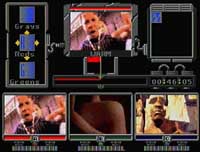
Kris Kross
Unfortunately, no hardware could have saved the Sega CD from its library of terrible games. The problem was that the Sega CD was capable of showing video. This was such a big deal at the time that they qualified it as "full-motion video (FMV)", although I'm unaware of any partial-motion or motionless video. But because of the hardware limits, the Sega CD really couldn't show
good video. The result was a grainy mess of huge, ugly pixels that occasionally moved and changed colors slightly. For some reason, game publishers thought this was the next big thing, so the majority of Sega CD games were really just collections of FMV that you had to sit and wait through, occasionally pushing a button to advance the story. One form of this was the "interactive music video", which resulted in a bunch of absolutely horrible "games" featuring bands that nobody would be caught dead listening to, even at the time of release, like Kris Kross.
The Sega CD was really terrible. It would have been higher on the list, but it actually had one good game: Sonic CD. It's arguably the best Sonic game ever released, striking a perfect balance between Sonic 1 and 2. It was so good that it actually convinced some people to buy a Sega CD. That's much more than I can say about any game for any of the other systems in this article.
5. 3DO

Panasonic 3DO
Like the Jaguar, I've never actually seen a 3DO, and I've never heard of anyone who had one. It's almost as much of a legend as the Neo Geo. The 3DO company was an early example of the Rambus business model: design and patent new hardware, then get other companies to manufacture and sell it, kicking royalties back. 3DO never produced anything tangible, and they convinced Panasonic, Goldstar (now
LG), and Sanyo to manufacture and sell their design.

$700 Road Rash.
Game consoles are usually sold at or slightly below the cost of manufacturing, since they usually contain cutting-edge hardware at release, yet must remain at a mass-market price point. The manufacturers and retailers make up for this loss by selling games and high-profit accessories (this is why controllers cost $30). With all software royalties going directly to 3DO, these hardware manufacturers could only generate a profit by selling the console with a high markup: most consoles launch at $200-300, and the 3DO was $700.
The gaming industry has never seen a successful console with a launch price above $300, and the 3DO was no exception. It bombed miserably. Nobody bought the 3DO, so developers didn't waste their time making good games for it. And even though it had excellent graphics capabilities, they weren't worth $700 to anyone.
4. Sega Game Gear

Sega Game Gear
Sega released the Game Gear in 1991 to compete with Nintendo's Game Boy. Its hardware was impressive: it had the core hardware of the Sega Master System with an increased color palette. They were so similar that many Master System games were ported directly to the Game Gear, and Sega later released an attachment to plug any Master System game right into the portable.

Beautiful 8-bit color
The problem was that the Game Gear wasn't very good at being a portable. Nobody ever wants to pay the same price for a portable as a full console, but the Game Gear launched at $200 when the Genesis was only $150. People also usually expect certain attributes from a portable, such as a compact size and a long battery life - the Game Gear couldn't fit in
any type of pocket, and it drained
six AA batteries in 2-3 hours. Maybe Sega thought that if people were willing to spend $200 on a portable, they'd easily shell out $3 per hour to use it. And for all of this price, weight, and battery drain, the benefits weren't huge - the early-LCD screen blurred horribly when anything moved. Sure, Nintendo's Game Boy did this too, but it was much smaller and much cheaper with more than twice the battery life.
But the Game Gear was not the worst portable game system ever released. Believe me, it gets much worse.
3. Atari Jaguar

Atari Jaguar
Atari released the Jaguar in 1993 for $250. Its competitors were the Super Nintendo and Sega Genesis, and you could buy both for the price of one Jaguar. Atari tried to justify the high price by advertising the Jaguar as a 64-bit system, but the claim was misleading - the main CPU was only 16-bit, with a 32-bit graphics processor and some secondary 64-bit helper processors. They didn't fool many people - the Jaguar is one of the few systems that I've never actually seen in real life. Atari later released the Jaguar CD attachment, shown here, which looked like a toilet and performed similarly in the marketplace, selling only its initial shipment of 20,000 units.

Jaguar controller
The Jaguar's controller is an interesting relic of experimental gaming hardware. During the craze for more buttons inspired by Street Fighter II, Atari elected to include a full 12-button numeric pad in the middle of the giant Jaguar controller. Instead of improving functionality, this just confused its users. Some games that used the buttons included descriptive overlay cards. Well, I guess nothing makes me feel more comfortable than having my game system do the same thing as cryptic DOS programs.
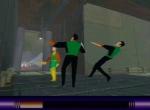
The Limbo?
Jaguar games were slightly nicer looking than Genesis and Super Nintendo games, but because the system hardly sold any units, very few developers actually made good games for it. The Jaguar CD was far worse - most of its games attempted to use polygons before hardware could use polygons
well. The game pictured here,
Highlander, is highly regarded in the Jaguar community for some reason. It's displaying at least 14 polygons, with most of them completely untextured. Maybe the developers realized that they didn't have to try very hard because nobody actually owned a Jaguar CD.
2. Sega 32X
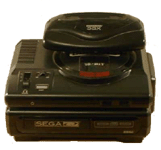
Genesis with Sega CD and 32X
Often referred to as the most poorly-planned console launch in history, the 32X existed (and failed) almost entirely because of poor communication. In early 1994, Sega of America started developing the 32-bit Genesis add-on that later became the 32X. Unfortunately, Sega of Japan was already making the Saturn, a completely new system that was much more advanced than the 32X. When the 32X was released in November 1994, gamers already knew about the upcoming Saturn, so they all waited for it instead of buying the stop-gap 32X.
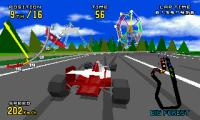
32-bit power!
For its part, the 32X didn't really do anything to help. It was a $150 add-on to a $100 console that already had a failed $250 add-on, and it wasn't anywhere near as powerful as the upcoming $400 system. Hardly anyone bought it, and it was common to see 32X systems for as low as $20 only a year after the initial release. The games were absolutely terrible, too - even though the Genesis and 32X were designed for displaying high numbers of colorful 2D sprites extremely quickly, most 32X developers elected to make 3D games. Since the hardware could barely handle 3D, it wasn't pretty. Most game scenes featured small numbers of large, flat, single-color polygons that flickered and warped constantly, with obvious pop-in at close distances.
Only 36 games were ever released, plus 5 that required the Sega CD and the 32X. I have no idea why a developer would choose to spend time and money making a game that required both failed Genesis add-ons, since they'd have a target audience of about 13 people, but these games actually existed.
1. Nintendo Virtual Boy
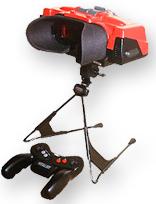
"Portable"
The Virtual Boy is an incredible showcase of terrible design. In 1995, Nintendo decided to make their own "virtual reality" system. The problem is that virtual reality (VR) never caught on - it was a cool idea, but it was never practical or cheap enough to have any mass-market appeal. Even now, an entire decade after VR fever, nobody uses it for anything. We now have the technological ability to produce VR helmets that could plug into a 3D-capable game console or computer and could cost less than $300, but nobody wants them. There are a number of good reasons for this, but the most damning is simply the way you look when you're wearing a VR helmet. Nobody wants to look
that nerdy. And because you can't share the experience with friends, like you can with a huge TV, everyone just watches you in your helmet and thinks you're an idiot. To see this phenomenon in action, pick a random gathering with friends, and try to socialize with a cardboard box on your head.
But VR wasn't a bad enough idea already. Nintendo decided to make the system portable. To the rest of the world, this means that it must be small, lightweight, and cheap, with the ability to run on batteries for many hours. When designing the Virtual Boy, Nintendo chose the unusual approach of ignoring all of these requirements. It's so large and heavy that gamers couldn't wear it on their heads, so Nintendo gave it a stand, requiring some sort of stable, flat surface to place it on while using it. Nintendo must have forgotten that its Game Boy, the most successful portable video game system in history, was mainly used in vehicles.
To give Nintendo credit, they probably knew that the flat-surface requirement wouldn't matter. Nobody could use it in a vehicle anyway, since it specifically prohibited use while in motion - the displays can be damaged if they're moved while operating. Not to be defeated by even stationary vehicles, Nintendo ensured that the system was as bulky as possible, at almost 2 pounds, and drained six AA batteries more quickly than the Game Gear.
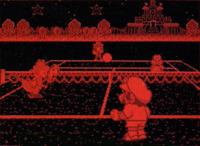
Virtual reality!
What did gamers get for all of this trouble and $180? Red. That's about it. To keep costs down, Nintendo used high-brightness LEDs and spinning mirrors to make the pictures. But since high-brightness blue and green LEDs weren't widely available in 1995, Nintendo used only red. Games were strictly red and black. But don't worry, Nintendo clearly labeled the box and the Virtual Boy itself with prominent warnings that it could cause eyestrain and vision problems. That's a great way to get people to buy a product. Games would even pause a few times an hour to force people to take eyestrain-prevention breaks.
Only 14 Virtual Boy games were ever released - that's one less than the Jaguar CD. I can't find any other game systems, no matter how badly they sold in the marketplace, that had fewer games than the Virtual Boy. It had the shortest lifespan of any console I've ever heard of. And amazingly, this colossal failure was actually made by Nintendo. I gladly grant it the title of Worst Game Console Ever Made, and I hope that geek history never forgets this spectacular failure.












